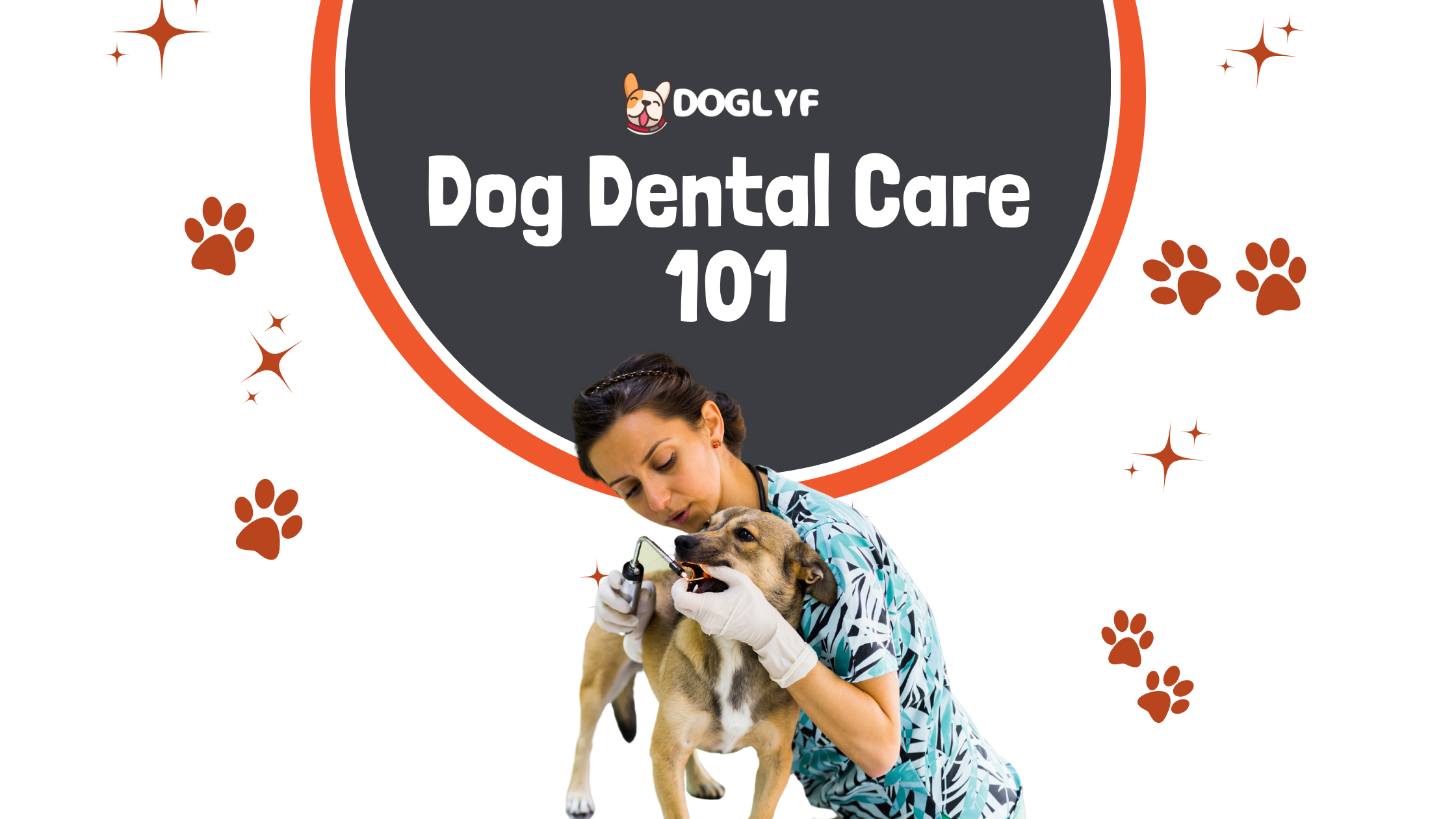This post may contain affiliate links. For more information about my affiliate disclosure, please click here
Are you a pet owner curious about Dog Dental care? Have you ever wondered how many teeth dogs have?
As veterinary dentists and hygienists, we know that canine tooth count is an essential factor when assessing oral health.
We want to provide some insight into this topic so that pet owners can better understand their pup’s pearly whites.
Check out our Dog’s Brain Training Program Here.
Dogs are one of the most beloved pets in the world – they bring us joy, unconditional love, and companionship. But did you know that proper dental care for our four-legged friends is essential for them to enjoy long lives full of freedom from pain and disease?
It all starts with understanding how many teeth dogs have.
The truth is that there isn’t just one answer since it varies depending on breed and age.
From Chihuahuas to Great Danes, puppies to seniors, each dog will experience different numbers of teeth during various stages of life.
In this article, we’ll explore why knowing how many teeth dogs have is essential and discuss ways to maintain good dental health or oral hygiene for our canine pals.
Also, Learn Dog’s Pregnancy 101 For Owners! How Long Are Dogs Pregnant?
Table of Contents
Overview Of Dog Teeth Structure
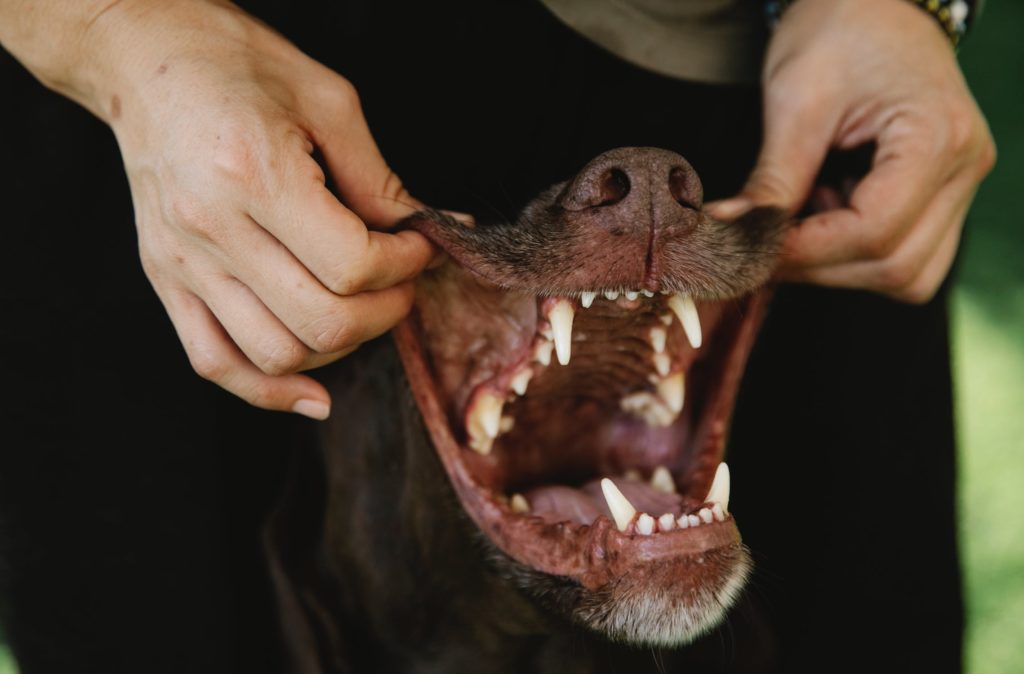
Canine teeth anatomy is fascinating and complex. Dogs have many different types of teeth, each with a meaningful purpose in the animal’s oral health.
Understanding canine dental anatomy can help us better care for our four-legged friends by keeping their mouths healthy and happy.
How many teeth do dogs have?
The first set of teeth that a puppy receives are called deciduous or baby teeth.
- These typically appear at around three weeks old and may include up to 28 tiny sharp teeth, which they will eventually lose when adult teeth come in.
- Adult dogs usually have 42 permanent teeth; 20 on the upper jaw and 22 on the lower jaw.
The incisors located towards the front of the mouth are used for grasping food, whereas molars towards the back are designed for chewing. Dogs also possess premolars acting as cutting tools and grinders for food intake.
It’s important to note that all dog breeds differ slightly in tooth structure due to evolutionary adaptations over time and slight variations from one breed to another.
Knowing how your pet’s particular breed evolved helps you determine what kind of dental care they might need throughout their lifetime—and ultimately keep them smiling wide! With these insights into canine teeth anatomy, let’s now take a closer look at the dental anatomy of dogs…
Dental Anatomy Of Dogs
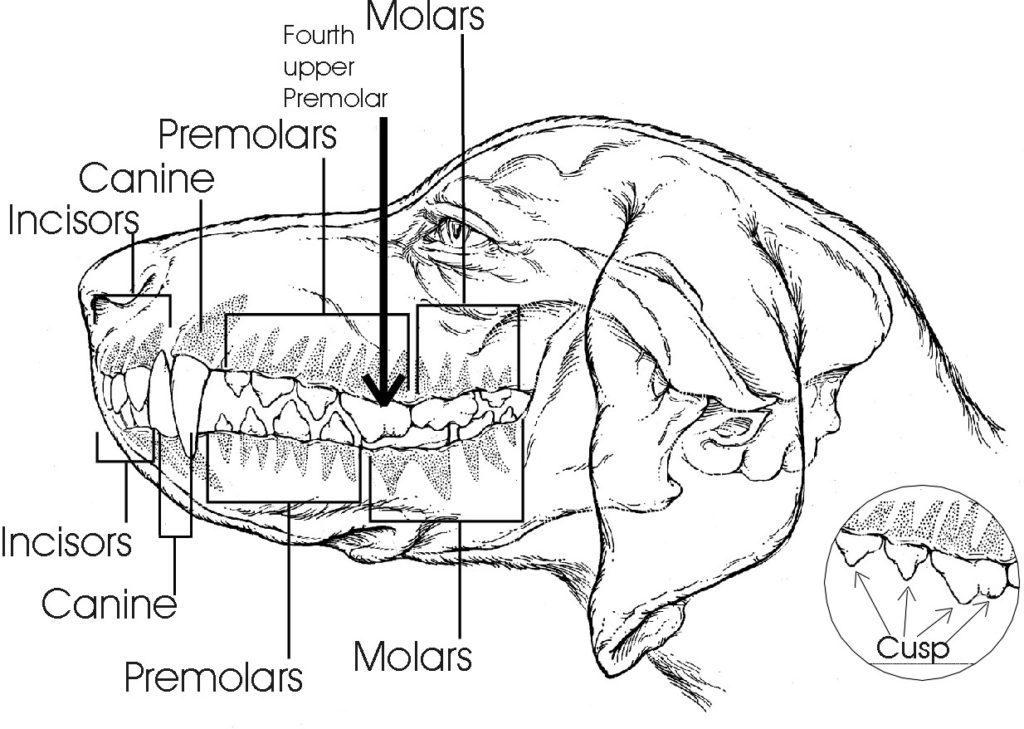
Dogs have 42 teeth in total, split into two different sets. Puppies can have up to 28 baby teeth, while adult dogs usually have 42 permanent teeth.
The dental anatomy of a dog is composed of incisors, premolars, and molars. Each type has its own specific characteristics that determine the individual’s overall oral health and well-being.
Canine incisors are small pointed teeth at the front of the mouth and serve as shearing or cutting tools for smaller food items such as kibble or treats. Dogs typically have 12 upper incisors and 10 lower ones on both sides of their jawline.
Canines also possess four canine teeth (commonly referred to as fangs) located between the incisors and premolars which help grip prey when hunting or tearing apart meaty bone snacks during playtime activities.
Premolars come next with 16 upper and 14 lower premolars situated behind the canine teeth for grinding down more significant pieces of food particles into bite-sized chunks before being swallowed.
Premolars are designed to crunch through harder foods like rawhide bones, carrots, apples, etc., making them an important part of any pup’s diet!
Molar teeth complete the set with 4 upper and 6 lower molars working together to grind down further still what was left by the premolars until it becomes fine enough to be ingested without difficulty.
It’s essential for pet owners to keep track of their furry friend’s dental anatomy since neglected dog dental care often leads to more severe health issues later on in life – from gum disease to tooth decay and even organ failure due to systemic infections.
Knowing how many types of canine teeth there are, and what they do individually within a whole system, allows us all to better understand our beloved pup’s needs so we can make sure they stay healthy & happy for years to come!
With this knowledge in hand, let’s move on to exploring puppy vs adult dog tooth structure differences.
Puppy Teeth Vs Adult Teeth
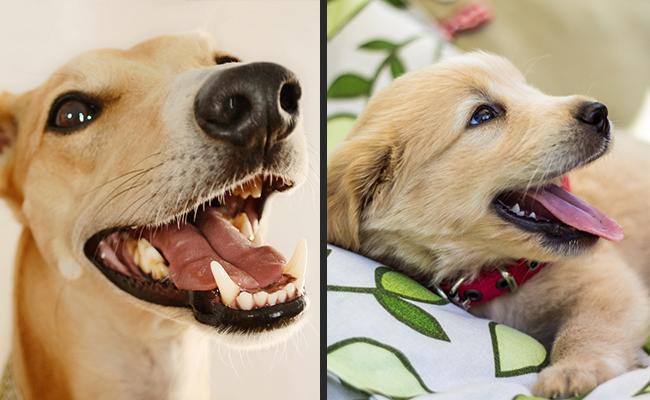
Puppy teeth and adult teeth are quite different. Puppies have 28 deciduous or baby teeth, which start erupting at around three weeks of age, while fully grown dogs typically have 42 permanent adult teeth.
There are several stages between the two where a transition occurs when the puppy starts to lose their baby teeth and gain their adult ones.
The difference in these tooth types is mainly seen in size, shape, and number; puppies obviously have fewer than adults due to having less room in the jaw for them all!
Regarding dog dental care, it’s important to understand that puppy and adult teeth need attention.
Puppy teeth require more frequent check-ups as they tend to be softer than adult ones, meaning they may need special cleaning treatments or sometimes even extraction if necessary.
Adult Dog teeth also require regular maintenance since they can become worn down from chewing bones or sticks over time – this should be done by your vet or a qualified veterinary hygienist.
Regarding differences between incisors, canines, and premolars, you should note that puppies usually only get two sets of molars, whereas adults will have four sets altogether.
Also, the shapes vary greatly depending on whether it’s a small breed dog or a large one; smaller breeds often have very narrow upper canines compared to larger breeds, which might have wider triangular-shaped ones.
Regardless of what kind of dog you own, proper brushing habits and routine visits to the vet are key for maintaining healthy gums and strong pearly whites!
Incisors, Canines, And Premolars

Dogs have 42 teeth, including incisors, canines and premolars. All these teeth are essential for dogs to perform daily activities such as eating, grooming and playing. Let’s take a closer look at each one of them!
Incisors are the smallest teeth in the front of the dog’s mouth above its lower jaw. They consist of six upper and six lower incisors, which allow the dog to bite off pieces of food or groom itself by licking fur.
Canine teeth, also known as fangs, make up four in number on either side – two above and two below the jawline. These sharp points help with breaking apart more challenging foods like bones.
Lastly, twelve premolar teeth come after the canines – 4 behind each dog on either side of both jaws, which aid in tearing apart meaty morsels.
Understanding canine anatomy is an integral part of understanding dog dental care.
This knowledge helps veterinarians diagnose any dog dental issues your pup may be having quickly so they can return to their happy-go-lucky selves again soon!
With proper care and maintenance from you—their loving owner—your pup will enjoy healthy gums for years. Now let’s move on to molars in dogs…
Molars In Dogs
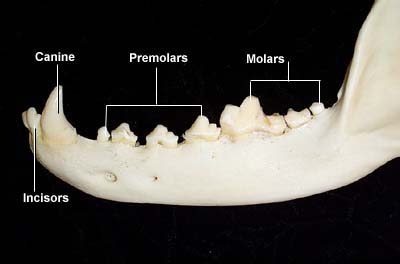
Now that we have discussed incisors, canines and premolars in dogs, let’s move on to molars. Molar anatomy is complex; this tooth type helps with grinding food for digestion.
The structure of these teeth are rounder than other teeth types and situated at the back of the mouth. When a pup’s jaws begin to grow, it activates the formation of molars – they typically form between 8-10 weeks old.
Taking care of your pup’s molars by brushing them regularly or providing dog dental chew toys is important.
This will help keep their mouths healthy but also reduce potential plaque buildup around their molars which could lead to periodontal disease later on in life. Regular veterinary checkups should also be scheduled so professional cleaning can occur if needed!
Understanding how many teeth a dog has started with knowing about all four categories: incisors, canines, premolars and now molars. By adding up each category, you can calculate the total number of teeth in dogs – 42!
Calculating The Total Number Of Teeth In Dogs

Calculating the total number of teeth in a dog is a crucial step when determining their dog’s dental care. Dogs have 42 adult teeth, which include 12 incisors, 4 canines, 16 premolars and ten molars.
Puppies start with 28 baby teeth that eventually fall out as they grow up. Knowing this information allows us to keep track of any changes or developments that happen within your pup’s mouth throughout their lifespan.
It’s also beneficial for owners to be aware of how many teeth are typical for a dog breed so we can look for discrepancies between the expected amount and what’s actually present.
For example, some larger breeds may only end up having 40 adult canine teeth instead of the usual 42 due to crowding from other adjacent teeth.
That being said, it’s still important to get regular checkups done by either a veterinarian dentist or dog dental hygienist every 6 months if possible!
So now you know how many pearly whites your pooch has but what about taking care of them? Regularly brushing and cleaning your pup’s chompers plays an essential role in keeping their mouth healthy and free from plaque buildup or infection.
In our next section, we’ll go into more detail regarding exactly how to do just that!
How To Clean Your Dog’s Teeth?

Cleaning your dog’s teeth is an essential part of their overall health and well-being. Regular brushing will help keep plaque buildup at bay and prevent gum disease, tooth decay, and other dental issues in the future. So let’s learn how to brush our canine companion’s pearly whites!
First things first – you’ll need the right tools for the job: a quality toothbrush specifically designed for dogs (not humans) and pet-friendly toothpaste that comes in flavors like beef or chicken. These products can be found at most pet stores.
It’s also important to remember not to use human toothpaste on your pup – it can upset their stomach due to its foaming agent, which isn’t safe for animals.
Now that you have all of your supplies, it’s time to start brushing! To begin with, aim for 1-2 minutes daily and work up from there if needed.
Make sure to get both sides of each individual tooth by gently angling the brush towards the gums so that you’re really getting into those hard-to-reach places where bacteria loves to hide.
If your pooch isn’t used to this routine yet, don’t worry; take it slow and offer lots of praise throughout the process. With patience and consistency they should come around eventually!
Regularly cleaning your four-legged family member’s chompers is key when it comes to maintaining good oral hygiene in dogs. Not only does it help protect against bad breath but more importantly, it helps them stay healthy both inside and out.
If you want even better results, consider visiting a professional veterinarian specialising in animal dog dental care every 6 months or so – they can provide a thorough cleaning and checkup, which may include X-rays or other treatments depending on what they find during the examination.
When To Visit A Vet For Dog Dental Care
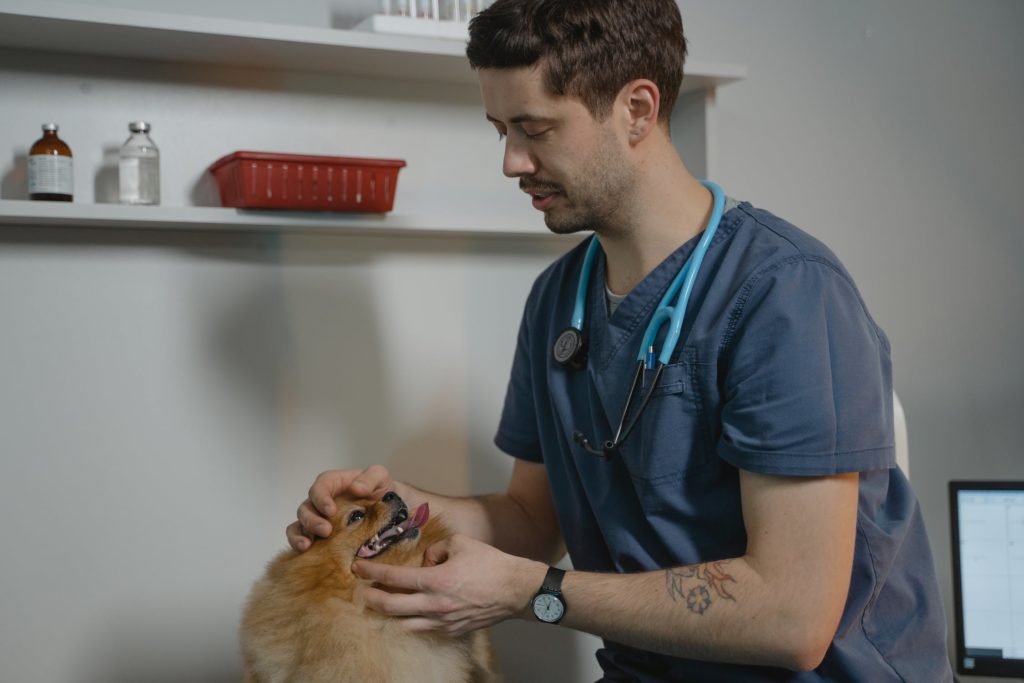
We want to ensure our canine companions have the best oral health possible. To achieve this, regular dog dental care from a vet is essential. It’s important to take your pup in for a check-up at least once a year or as their vet recommends.
However, if you notice any signs of poor dog dental care, such as bad breath, yellowed teeth, redness and inflammation in the gums, then it’s time for an immediate visit to the vet.
Significant plaque build-up can lead to periodontal disease, which can cause pain and discomfort for your four-legged friend.
Regular brushing and professional cleaning are needed to keep these problems away – but only a trained veterinary dentist will be able to provide a detailed assessment and treatment plans tailored specifically to your dog’s needs.
A trip to the vet isn’t just about preventing dog dental diseases; tooth loss is more common than you think! Dogs typically have 42 permanent teeth, so losing even one could affect their overall well-being.
Owners must recognize the importance of taking their pets in for regular visits with a qualified veterinarian specialized in providing comprehensive dog dental care services – they’ll be able to identify issues before they become serious enough to impact on general health.
With early detection and proper preventative measures implemented, we can help ensure our beloved dogs live long, healthy lives free from unnecessary pain caused by suboptimal oral health.
With adequate attention paid towards preventive pet dental care, we can work together to avoid any potential complications arising from poor oral hygiene down the line.
Possible Complications From Poor Oral Health
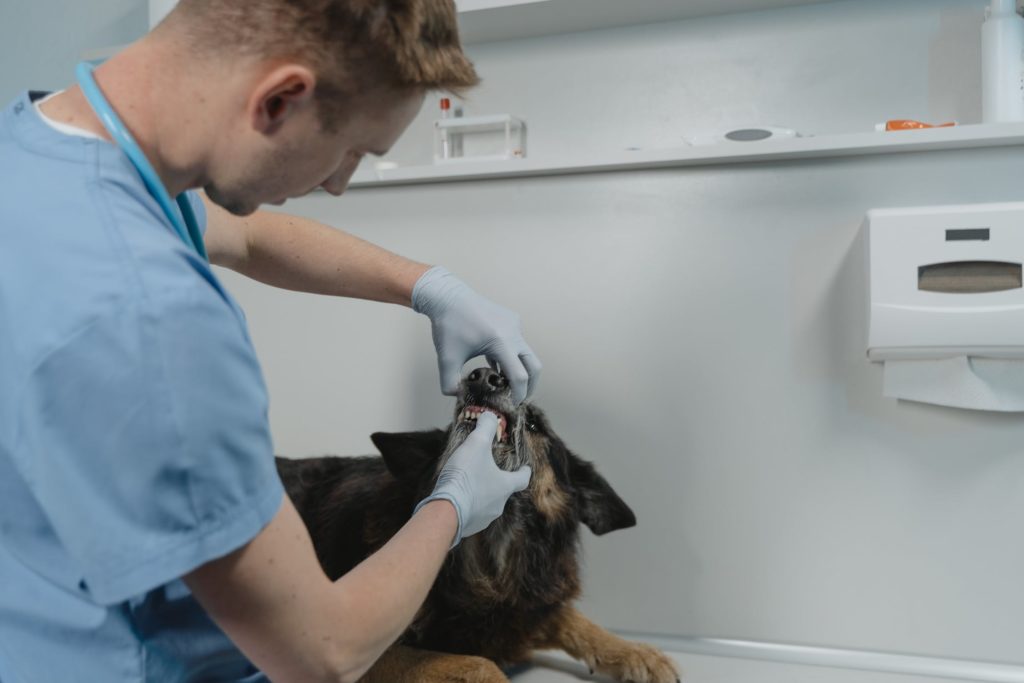
Dogs have 42 teeth, including incisors, canine teeth, and molars. While it is essential to maintain dog dental care, poor oral care can lead to severe complications.
From dog gingivitis to doggy tooth decay and even canine dental infections – if left untreated, your pup could be in severe pain!
Periodontal disease is one of the most common issues caused by poor oral hygiene in dogs.
It begins as an inflammation of the gum tissue. Still, it can quickly progress into advanced stages, including foul breath odours, infection, bone loss around the roots of teeth and eventually tooth loss.
If you suspect that your dog may be suffering from periodontal disease or any other form of dog dental care issue – seek professional help immediately to ensure that they get the proper medical attention needed.
Not only are there physical repercussions associated with poor oral hygiene – emotional issues such as stress or anxiety can also arise due to chronic discomfort from bad breath or painful cavities or abscesses.
A regular cleaning routine at home combined with checkups at the vet will keep your pup healthy and happy!
Tips For Keeping Your Dog’s Teeth Healthy
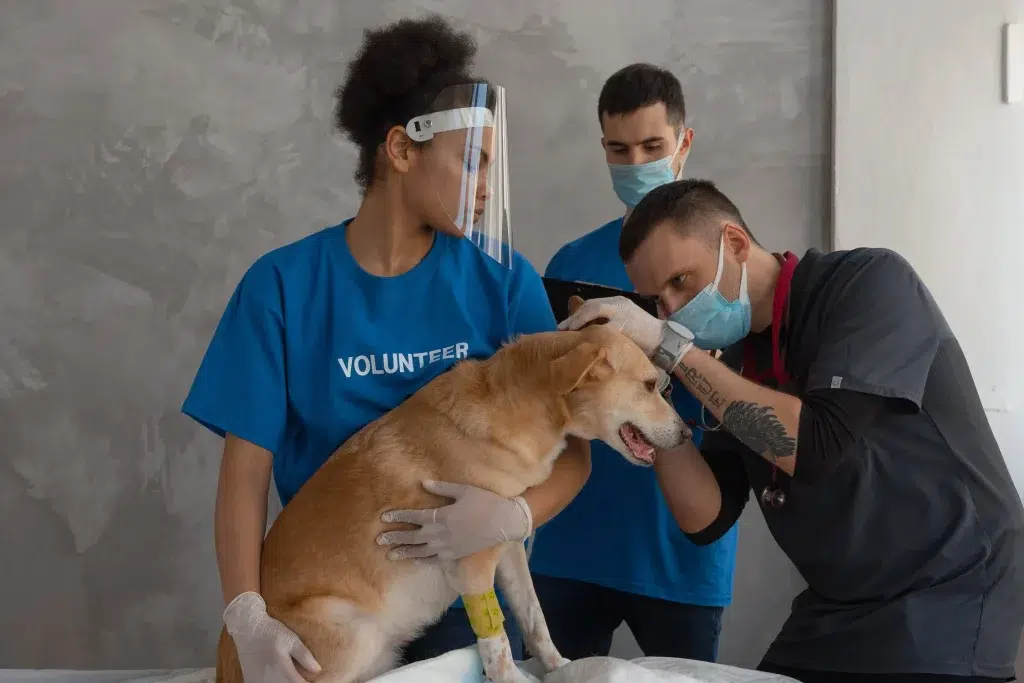
Having a healthy mouth for your pup is important. Your dog has 42 teeth, and you must care for them properly to protect their smile from developing any painful dental issues. Here are some tips to help keep your pup’s pearly whites sparkling!
- First off, brushing your dog’s teeth regularly should be part of your regular routine. Doing this will help remove plaque buildup which can cause decay over time if not removed.
- Ensure your toothbrush or finger brush is specifically made for dogs – human brushes tend to be too hard on their gums.
- Also, make sure the toothpaste you use contains enzymes and/or xylitol, as these ingredients are meant to reduce inflammation and balance out pH levels in the oral cavity.
- In addition to regular brushing, there are other ways you can promote good dental hygiene for your pet.
- Many veterinary dentists recommend using specialized oral health products like water additives, chew toys, and treats designed with tartar-fighting ingredients.
These items can help preventative dental disease by reducing bacteria growth in your pet’s mouth over time.
Caring for your pup’s teeth isn’t just about brushing – it’s also about examining his or her mouth at home every few weeks for signs of gum disease or cavities.
If anything looks suspicious, contact a veterinarian immediately for further evaluation and treatment recommendation so that problems don’t go untreated before they become serious. Taking these steps now will ensure your furry friend enjoys strong oral health throughout life!
Frequently Asked Questions
We Hope we have answered all your problems related Dog Dental care, But in case, we missed something, then we are listing some frequently asked questions related to dog dental care.
How Do I Know If My Dog Has Dental Problems?
When it comes to dental problems in dogs, it’s important for pet owners to be aware of the signs and symptoms.
- Bad breath odour is one of the indicators that something may not be quite right with your pup’s teeth.
If left untreated, this can become a more serious problem as bacteria accumulates in the mouth. Other common signs are loose teeth, bleeding gums, and discoloration of the teeth.
It’s essential to keep up on regular preventive care and checkups to catch any potential issues early before they become bigger health concerns.
A veterinary dentist or hygienist will examine your dog’s mouth during their visit and look out for possible red flags such as tartar buildup, cavities, worn down enamel from chewing hard things like bones or toys, gum disease, fractured teeth, bad bite alignment (malocclusion), etc.…
They will also clean the surface of each tooth to remove plaque or calculus build-up which helps prevent further decay over time.
Taking proactive steps towards maintaining good oral hygiene can help keep your furry friend healthy and happy while giving them long lasting freedom from unnecessary pain due to dental diseases!
Regular brushing at home with an enzymatic toothpaste designed specifically for pups along with annual trips to the vet should do just fine in keeping those choppers looking sharp!
Do All Breeds Of Dogs Have The Same Number Of Teeth?
The question of whether all dog breeds have the same number of teeth is an important one that needs to be answered.
As veterinary dentists and dental hygienists, we strive to understand how many teeth each breed has to detect any potential problems with their oral health.
Understanding this information can help us make sure our canine companions remain healthy and happy.
When it comes to the amount of teeth a dog has, there are several factors at play. The size and shape of the mouth, as well as jaw structure, are just some of the elements that determine how many teeth a particular dog will have.
Different breeds also vary from one another when it comes to tooth count – some smaller dogs may only have 28 teeth while larger ones could potentially have 42 or more!
It’s essential for pet owners to know about differences between breeds when considering their pup’s dental health. Regular checkups and cleanings by a vet dentist or hygienist are key for maintaining good oral hygiene and making sure your pet’s smile stays healthy throughout their life.
Additionally, understanding the typical number of teeth per breed can help you identify any abnormalities if they arise, allowing you to take action quickly should anything appear out of the ordinary.
By staying informed on both regular maintenance techniques as well as common variations among different dog breeds’ dental features, you can ensure that your furry friend is getting proper care and attention regarding their pearly whites so they can live long and vibrant lives without having to worry about toothache pain or other issues associated with poor oral health!
What Are The Signs Of Good Oral Health In Dogs?
Good oral health is just as important for dogs as it is for humans. As a veterinary dentist or dental hygienist, one of the first things I look out for are signs that indicate a dog’s oral health may be in need of attention.
There are several key indicators that can help you determine if your pet’s dental hygiene needs to improve.
One way to monitor your dog’s dental health is by looking at their teeth and gums regularly.
Make sure there isn’t any plaque buildup on their teeth; inspect them for any discoloration, chipped, cracked or broken teeth, or excessive tartar around the gum line. You should also check inside their mouth for any abnormal lumps or bumps which could be indicative of an underlying issue such as periodontal disease.
Making sure your pooch has regular tooth brushing sessions combined with professional cleanings from time to time will go a long way towards keeping their dental health in check.
Additionally, scheduling a dental health check with your veterinarian at least once per year will ensure issues like gum disease don’t go undetected until they become serious problems.
These steps provide peace of mind while helping maintain good oral hygiene in dogs – something we all want our furry friends to have!
Are There Any Special Treatments For Dogs With Dental Problems?
When it comes to special treatments for dogs with dental problems, it is important that owners understand the importance of proper preventive care.
Dental care can help reduce or even prevent many common issues, such as plaque and tartar buildup on dog teeth. Therefore, if your pup has a dental issue, you should consult a veterinary dentist or hygienist right away.
Dogs have an average of 42 teeth, so maintaining oral health requires regular brushing and professional cleanings. If left untreated, poor dental hygiene can lead to periodontal disease which causes pain, bad breath, and loss of appetite in dogs.
Special treatments including scaling, root planing and polishing may be necessary in more serious cases. An X-ray exam may also be recommended to identify any underlying issues with the jaws or gums.
It’s essential that pet owners take proactive steps to maintain their canine companion’s oral health by teaching them how to brush their teeth and scheduling regular checkups at the vet clinic.
With early diagnosis and treatment from a trained veterinarian specialist, your furry friend will experience fewer dental issues over time and enjoy better overall physical health.
For optimal results, follow your vet’s advice about specific oral hygiene routines tailored for your pup’s needs – this could include home toothbrushing or other types of maintenance visits depending on the severity of their condition. Taking these measures now will ensure long-term benefits for both you and your pooch!
Are There Any Foods That Help Keep My Dog’s Teeth Healthy?
When it comes to keeping your dog’s teeth healthy, diet plays a major role. It is important for canine owners to be aware of the foods that can help promote good dental health in their pets.
From oral hygiene treats to nutritious snacks, there are plenty of options available to maintain the overall wellness of your pet’s mouth and teeth.
The first step towards providing a healthy dental diet for your canine companion is selecting appropriate food choices such as kibble or other soft chews designed specifically for dogs. Kibble helps remove built-up plaque from your pup’s teeth while also promoting fresh breath.
Additionally, certain human foods like carrots and apples can act as natural toothbrushes when given raw or slightly cooked. These crunchy snacks contain abrasive properties which will help scrub away bacteria on the surface of your pup’s teeth without harming them in any way.
There are also various brands of dental health snacks made especially for pups that offer an assortment of vitamins and minerals essential for optimal oral hygiene care.
Such products include specially formulated bones, sticks, and chews designed with added benefits to keep your pup’s gums clean and free from tartar buildup over time.
By incorporating these into their daily routine, you not only provide necessary nutrition but strengthen the bond between you and your furry friend through interactive playtime activities!
Keeping up with regular vet visits is just as important as watching what goes into each meal bowl. Having professional cleaning treatments done periodically is key to staying ahead of potential issues before they arise; this ensures optimum canine tooth health throughout all stages of life!
Conclusion
It is important to be aware of your dog’s oral health. Most breeds have 42 teeth, however there are some variations depending on the breed. A good way to check for dental problems is by taking a look at their mouth and checking for any discoloration or broken teeth.
Additionally, it is important to pay attention to signs such as difficulty eating, bad breath, and excessive drooling as these can all point towards an underlying dental issue.
To prevent future issues from arising, regular brushing with toothpaste designed specifically for dogs should be done in addition to having them checked out by a vet every six months or so.
There are also certain foods that can help keep their teeth healthy such as crunchy kibble and rawhide chews.
Overall, it’s important to maintain your pup’s oral hygiene just like you would yours! With proper care and preventive measures, we can make sure our furry friends stay happy and healthy for years to come.
